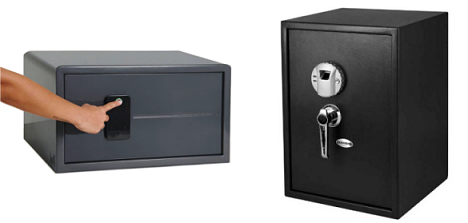Biometric gun safes, also known as fingerprint safes, are a special type of gun safe. They use biometric data, such as a fingerprint or facial recognition, to provide access to the safe.
Here’s how biometric gun safes work:
First, the owner registers their biometric data, such as a fingerprint, with the fingerprint safe’s locking mechanism.
Then, when the owner wants to access the safe, they place their finger in front of the locking mechanism. The safe’s sensors then compare the biometric data to the registered data to verify the owner’s identity.
If the owner’s biometric data matches the registered data, then the locking mechanism releases, giving the owner access to the contents of the safe.
Some advantages of using a biometric gun safe over other types of safes include:
Convenience
Biometric gun safes offer quick and easy access to firearms without the need for a combination or key. This can be especially useful in situations where quick access is important, such as in a self-defense scenario. Some fingerprint gun safes are designed to fit inside a nightstand drawer for ready access anytime.
Security
Biometric technology provides a high level of security because it’s difficult to fake or replicate biometric data. This helps prevent unauthorized access to firearms, reducing the risk of theft or accidental discharge.
Customizable
Biometric gun safes often allow for multiple users to register their biometric data. That makes it easy for multiple family members to access the safe. Some safes allow as many as ten individuals to register their fingerprints.
Some disadvantages of using a biometric gun safe include:
Cost
Biometric gun safes can be a bit more expensive than traditional safes because they require specialized technology. However, for many people any premium they pay is well worth the convenience a fingerprint safe can provide.
Reliability
Biometric technology is not foolproof, and can sometimes fail to recognize registered biometric data. This can be frustrating if the owner is unable to access the safe when they need to. That’s why many owners buy a biometric gun safe that also includes a touchscreen keypad or a key to unlock it with.
Power source
Biometric gun safes require a power source to operate, such as a battery or electrical outlet. If the power source fails, the safe may not be able to be opened. Many fingerprint safes have built-in alarms to let the owner know when the batteries need replacing.
In conclusion, fingerprint safes offer a high level of security and convenience. This makes them a popular choice for gun owners . However, they can be more expensive and may not be as reliable as traditional safes. Ultimately, the decision to use a biometric gun safe will depend on the owner’s specific needs and preferences.
Are you interested in looking at more biometric gun safes? Click here now.
This website is a free service and it includes affiliate links. When you buy something through them, this site may earn a small sales commission.

